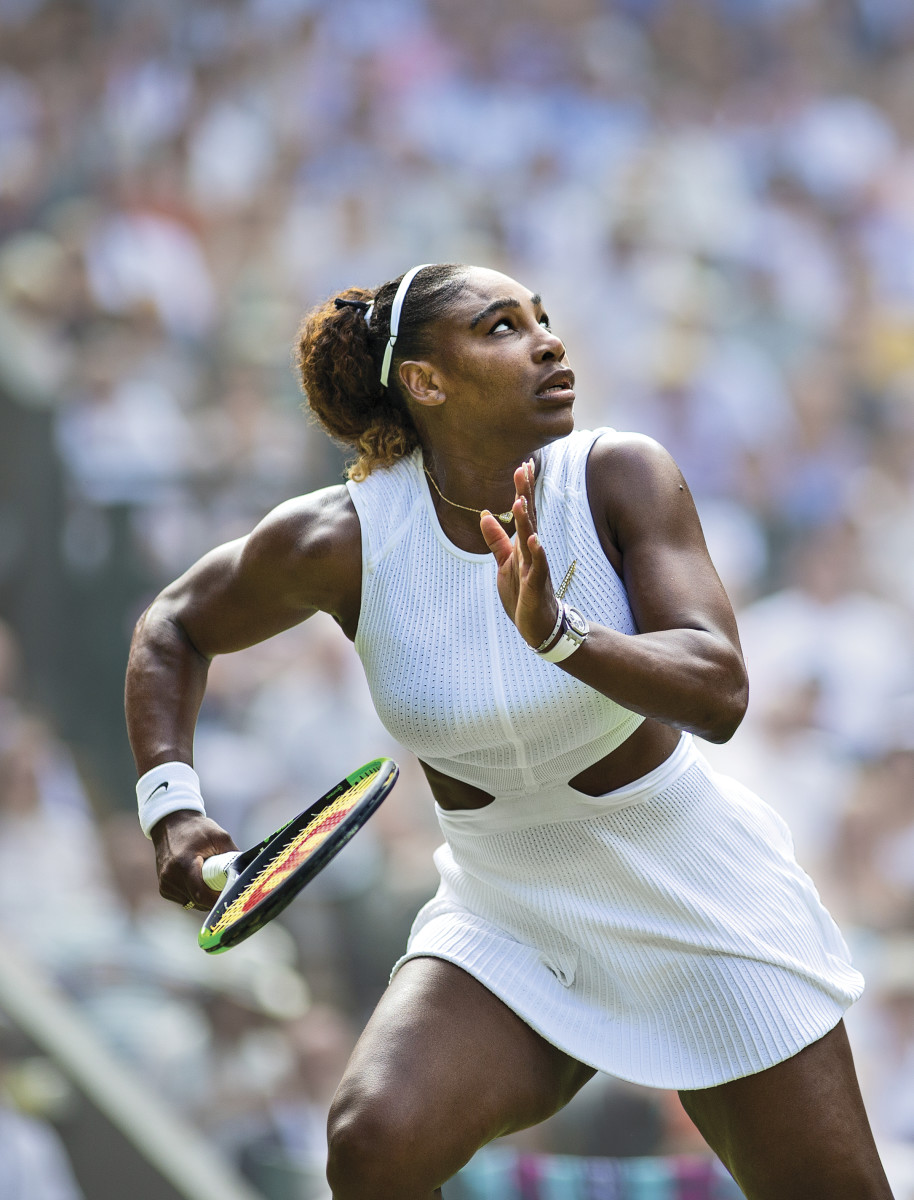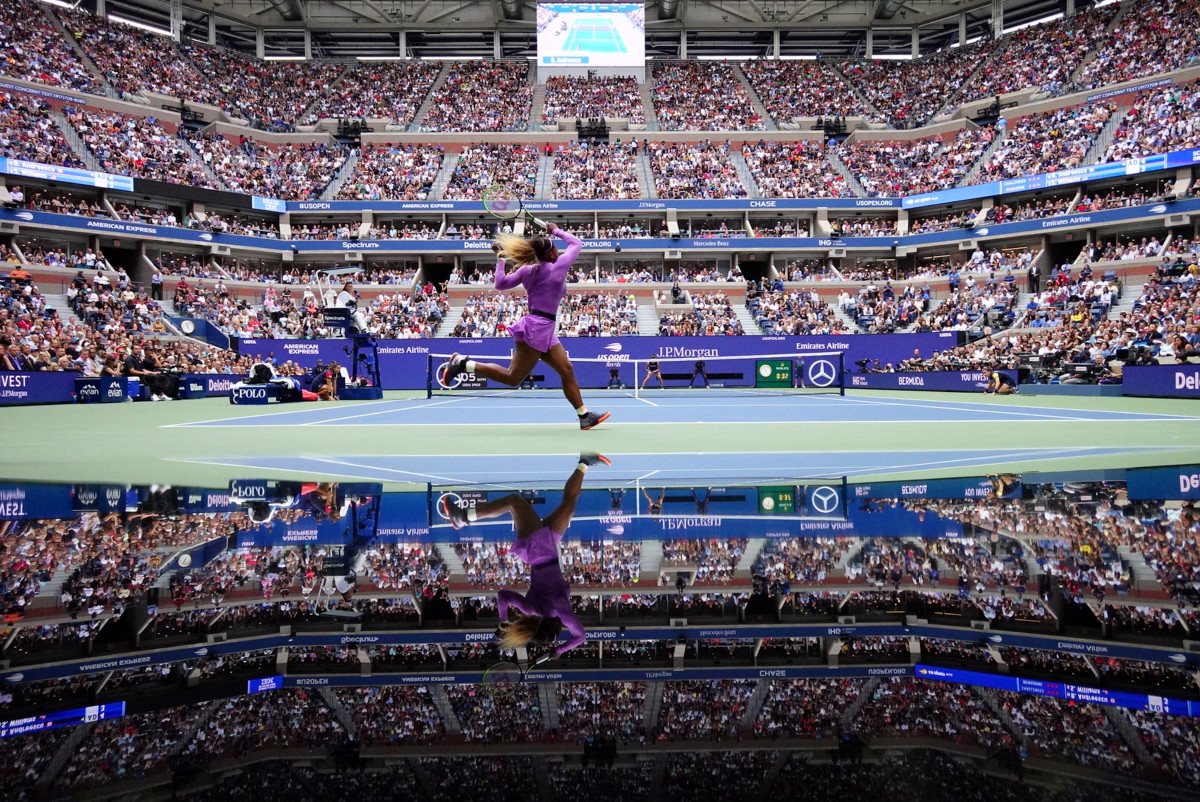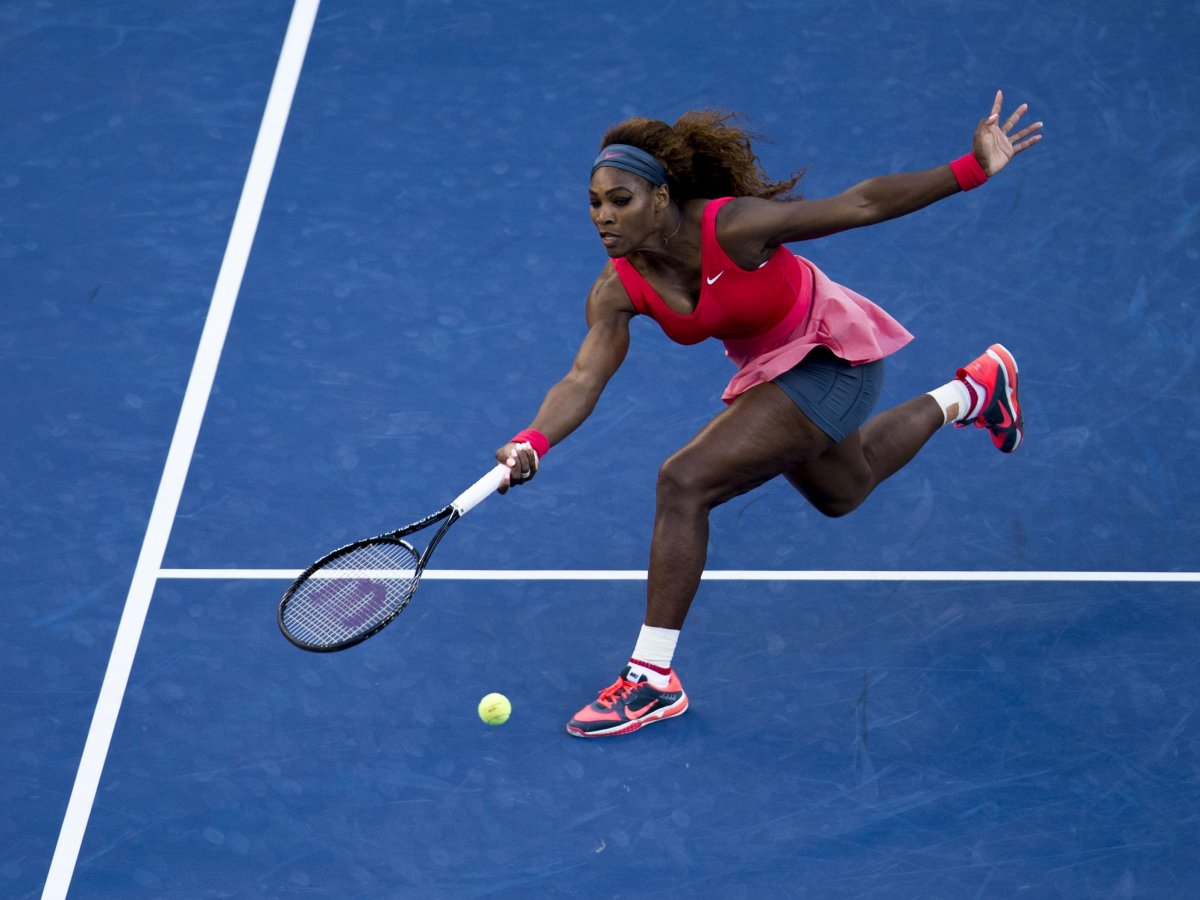Serena Williams Changed Sports Forever
Editors' Note: This story, republished in light of Williams’s announcement that she will retire following the 2022 U.S. Open, originally ran on June 27, 2022.
It has been easy to find Serena Williams lately. At awards shows and galas. Starting a venture capital fund. Reveling in the company of her daughter, Olympia. As a pitchwoman for Michelob Ultra and Subway and Chase and DirecTV and migraine pain relief.
But it has not been easy to find her at a tennis match. On June 26, 2021, Williams played on Wimbledon’s Centre Court, the lawn she had spent more than two decades dominating. A few minutes into her first-round match, Williams slipped on the grass and injured her leg. It may simply have been an unfortunate accident. It may have been due to the wear and tear of years and years of tennis—these things happen to bodies of even the most agile among us as we get older. Regardless, afterward, she went nearly a year without playing a professional match.
Which is how it came to be that Wimbledon 2022 experienced its first upset, its first ripple-through-the-field surprise result before the first ball was struck. In mid-June, Serena confirmed she would take a wild-card into the event. She turns 41 in September. Her ranking is 1,204 in the world—1,203 spots off her career-high. Yet, she sent a clear message: I’m not done yet.

How will she fare? If history is any indication, well, who knows? Williams could, conceivably, storm back and win. A tennis article of faith: This is a player you underrate at your peril. Yet, signs indicate the queen’s reign is over—40-year-old athletes don’t take gap years and resume their supremacy. History also suggests (strongly) that Serena dispenses with most formalities and conventions, and is thus likely to forgo a traditional retirement announcement, much less a maudlin retirement tour. Maybe this doubles as a start to a fitting farewell.
Let us then look back at one of the towering athletes—sport and gender be damned—of this generation.
Serena Williams was not yet 17. She had just faced an opponent who looked nothing like her, in front of thousands of fans who looked nothing like her, and now she was facing inquisitors in the U.S. Open media room full of people who looked nothing like her. It was the fall of 1998, when Serena and her older sister, Venus, were still in the alterna-band stage, hardly the full-blown transcendent, transformational rock stars they soon would become.
Still, their remarkable story was starting to be told, two sisters from Compton making their mark and leaving their heelprint on a sport decidedly not inner-city. In the press conference, a discussion arose over the origins of the word “ghetto.” A journalist attributed it to Eastern Europeans. Serena believed the word derived from the Black community. At one point, the journalist pulled out a dictionary and read the etymology, supporting his contention. Serena smiled. “You have your information,” she said dismissively, “I have mine.”
For the innumerable memorable moments that define the singular career of Serena Williams, this one, admittedly a deep cut, scarcely gets mentioned. But what a prelude. What a harbinger. Here was a 16-year-old in a new environment, projecting unshakeable, unblinking confidence and self-belief, rising above one in a long line of microaggressions she would encounter. Not even Webster’s damn dictionary could wrong her. She knew what she knew—and didn't much care if you agreed with her or not.
One year later, Williams returned to the U.S. Open and would take the women’s singles title, beginning a dizzying run of successes—spanning three decades and seven presidential terms—that would see her win 23 major singles titles, take her place among the most accomplished players to pick up a racket and become one of those we-will-tell-our-grandkids-we-saw-them athletes. For most fans and observers, Serena entered the GOAT pasture years ago. And still, the declaration of “best ever” doesn’t adequately capture the dimensions of her impact, an athlete unmatched in her path-breaking and trailblazing.
Her career has not merely been cinematic, but literary. There is a gripping story, but also larger themes. She has been unmistakably the heroine, the protagonist, but there are rich supporting characters. Her story comes with rising and falling actions, plot points, conflicts and resolutions. Not unlike a tennis match, it can be divided into sections. There was an electric beginning and hefty middle and, so far, a graceful conclusion.
Serena turned pro in the mid-90s. It was right around the time when the movie King Richard ends and when Richard Williams, IRL, told the world his youngest daughter was just as good at tennis as his older one, Venus, but had the added sports virtue of being “meaner.” Before the staid world of tennis could adjust to the groundbreaking effects of the Williams family—the beads, the bombastic father, the smashing of so much conventional tennis wisdom as though it were a sitting floater—the sisters were winning matches as a matter of course.
Though Serena broke through in 1999, it would take her nearly three years to win another major. In that time, birth order was restored, as Venus ascended to become the game’s dominant force. As often as casual fans and mainstream media talked about “The Williams family”—conflating the sisters into what Martina Hingis once described as “a two-headed monster”—the enormity of this story was still somehow underplayed. This was the equivalent of Tiger Woods dominating golf, while, if you can imagine, his little brother, Lion, was the second-most accomplished golfer on the planet. Two sisters, from the most unlikely tennis origins, batting the top position in a global sport back and forth as if they were having a knockabout in the backyard.
If the Williams sisters were the best in the business, the rankings didn’t always reflect that. They played on their schedule, where and when they wanted. At times, this greatly dismayed the WTA Tour, sponsors and tournament promoters. (It is also why they are both set to retire in their 40s, full decades after their like-aged colleagues.)
By 2002, Serena brought the full force of her “mean” to bear and decided she’d had enough of losing to her big sister. Serena overcame the awkwardness and put aside sororal guilt to beat Venus in the final of the French Open. Then Wimbledon. Then the U.S. Open. At one point, Serena won five of the six majors she entered, marrying unanswerable power with accuracy, poise and strategy—she never got enough credit for strategy—like no other player. (You don’t win 23 majors without owning power and deploying it wisely.)
Then, a plot point. Days after the 2003 U.S. Open, Yetunde Price, Venus and Serena’s oldest sister, was murdered in Los Angeles. Serena was overcome with grief and, by her own admission, lost focus. Over the next three years, she won only one major. More than one former champion likened her to a comet burning out.

But while there was no single moment of reckoning, the years that followed saw another patch of relentless success. By 2010, Serena was in her late 20s and had won 13 Grand Slam singles titles. After she took the Wimbledon title for the fourth time that year, Sports Illustrated declared her the Best Ever, splaying it across the cover.
Days later, though, Serena cut her foot, suffered a pulmonary embolism and was, in her words, on her “deathbed.” In 2012, she returned a shadow of her former self. After losing, tearfully, in the first round of the French Open—the earliest loss of her career at a major—there was an unmistakable sense she was edging toward the concluding stages of a grand career. She was 30, the same age as the great Steffi Graf when she retired, and, well, it had been a hell of a run.
Then, yet another plot point: Williams hired a new coach, a suave and self-promoting Frenchman, Patrick Mouratoglou. And the titles kept coming. We can debate causation versus correlation. (As with Richard Williams, we ought to resist giving too much credit to the tennis coach, who might motivate and provide counsel, but ultimately it’s the player on the court executing alone.) But the results came fast and furious.
Barely a month after that humiliation in Paris, Serena won Wimbledon yet again. At the 2012 Olympics, she turned in, for our money, the most comprehensively dominating event of her career—there are a lot to choose from—barely losing games against her rival/non-rival Maria Sharapova in the gold medal match. In the first dozen majors she played after that dismal French Open defeat, Serena won seven. In ’15, she won the first three majors and turned in one of the most towering seasons in tennis history despite not completing the calendar Slam.
READ SI'S SPORTSPERSON STORY ON SERENA WILLIAMS, FROM 2015
Still blazing her way through draws deep into her 30s, Serena won her 23rd major at the 2017 Australian Open. Somehow fittingly, as Donald Trump was being inaugurated, Serena was beating her big sister in the final while pregnant. Having spent the first two decades of her career resisting the pull of history, she pivoted her professional attention to her legacy. Her new rival would become a woman four decades her senior: Margaret Court, now a pastor in Australia, whose 24 career majors set the standard.

Comparing Serena’s achievements to Court’s is the ultimate apples-to-oranges. Eleven of Court’s titles came at the Australian Open when it was a major in name only—a 32-player draw with a field made up of almost exclusively Aussies. This bore only as much relation to Serena’s various majors—128-player draws with an international field of full-time players—as both runs entailed hitting a ball over a net. But if this record was the motivation Serena required to stay active, so be it.
Matching and surpassing history has been delayed, however. First, there was some time off after her marriage to Alexis Ohanian and the birth of their daughter. Still a high-achiever in her late 30s, she was a match away from completing her quest, but Serena could not conjure the Serena of old in a 6–3, 6–3, loss against Angelique Kerber in the 2018 Wimbledon final.
There is something noble about her setting this ambitious goal, even if it is never unattained. And, besides, she has already won in so many ways. She has won the respect and affection of so many, not least within the tennis world, which didn’t always warm to her at the start. What was once seen as contrarian is now seen as innovation. What was once seen as cocky or arrogant is now scanning as female empowerment and confidence. When she played Venus for the 29th time at the 2018 U.S. Open, the occasion doubled as a celebration of tennis’s first family, with 20,000 fans, including Oprah and assorted Jenners and Kardashii, coming to pay respects.
For all the times towering athletes go underappreciated until they’ve stopped, Serena has happily stuck around long enough to feel the embrace—and hug back.
Even a four-act structure overlooks and shortchanges her textured career. Serena has established herself as one of the most accomplished doubles players in history. Partnered with Venus, she wore a smile and bore a playful demeanor, seldom in evidence when she played solo. Yet the results were very much the same. Consider, the team of Williams-Williams won 14 major titles, never losing a final, and three Olympic golds. For comparison: brothers Bob and Mike Bryan, generally considered the best men’s team of all time, and who devoted themselves exclusively to doubles, won 16 majors.
While the PGA Tour still looks a lot like it did when Tiger Woods burst on the scene, it’s hard not to notice a “Williams Effect” in tennis. More than half the American women in the top 100 tennis players are Black. Innumerable players outside the traditional demographic have picked up the sport, knowing a country-club membership is no prerequisite.
As long as Serena was winning events and capturing audiences, the majors could not possibly pay women less than men. And they no longer do, also due in large part to behind-the-scenes work from Venus. Tennis embraced technology to determine line calls, something owed largely to Serena. She was robbed at the 2004 U.S. Open, rightly complained and, as a result, human error has been reduced. She led the way in pushing tennis’s fashion boundaries with her beads and boots and catsuits. She has been an exponent for maternity leave and body positivity. No less than Roger Federer marveled at how Serena’s “confidence as a woman transfers to her tennis. She always finds a way.”

Along the way, she has offered us, and maybe herself, abundant lessons. There is no substitute for competitive resolve—Serena so often competes as though she is refusing to accept that defeat is among the battery of options.
Sports—and tennis, in particular—are a beautiful meritocracy. There is no one right background, no one right path, no one approach to your career. Win, and nothing else matters. If there were some regrettable moments along the way, they partially underscored Serena’s greatness. She has been superhuman, but she was—is—very human and complex like anyone else. That Serena was fined for threatening a lineswoman with asphyxiation-via-tennis-ball at the 2010 U.S. Open, that she was penalized in the ’18 U.S. Open final—those are also part of her legacy. So be it.
If she never gets to her goal of 24 majors, it’s a minor footnote. And a lesson, too. Even if you don’t achieve it, the courage of stating a goal and going for it is, in itself, worthy and righteous.
After a quarter century and so many false starts, we now brace for the post-Serena era. When the day comes, we will hear that the sport is poorer for it. True as that may be, one could as easily argue that, thanks to this towering champion and all she has contributed, doing it her way from start to finish, women’s tennis has never been richer.
